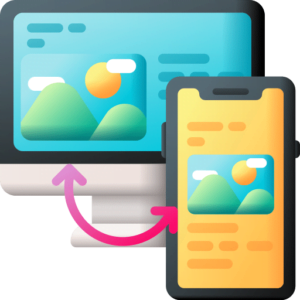Website design trends are the current popular styles and techniques shaping how websites are crafted. They encompass aesthetic choices, technological advancements, and evolving user expectations. These trends influence everything from layout and color schemes to interactive features and functionality. By aligning with these trends, designers can ensure that websites stay fresh, engaging, and effective in meeting modern user needs.

Top Website Design Trends in 2024
Website design trends refer to the prevailing styles, techniques, and technologies that influence how websites are created and presented. These trends often reflect broader shifts in technology, user behavior, aesthetics, and industry standards. Keeping up with these trends is crucial for designers and businesses to ensure that their websites remain modern, effective, and competitive.
What do you mean by design trends for websites?
The Visual Trends Shaping 2024
1. Immersive 3D Elements
- Interactive Product Displays: Businesses are using 3D to showcase products from multiple angles, allowing users to interact with and explore items in a more detailed and interactive manner.
- Dynamic Backgrounds: 3D backgrounds add visual interest and create a more immersive environment for users as they navigate through the site.
2. Glassmorphism and Neumorphism
- Depth and Texture: These styles create a sense of depth and physicality, making UI components feel more interactive and intuitive.
- Focus on Usability: Both trends enhance the visibility of interactive elements like buttons and sliders, improving user experience through clear visual cues.
3. Bold Typography
- Brand Personality: Unique typography helps convey a brand’s personality and differentiate it from competitors.
- Enhanced Readability: Creative use of typography can also improve readability and overall design coherence, making content more accessible and engaging.
4. Vibrant Color Palettes
- Visual Hierarchy: Vibrant colors help highlight important elements, guiding users’ attention and improving navigation.
- Brand Differentiation: Unique color combinations can help brands stand out and create a distinctive visual identity.
How Trends are Improving Usability
1. Enhanced Accessibility Features
- Keyboard Navigation: Enhanced keyboard navigation ensures that users who rely on keyboards rather than mice can access and interact with all website elements easily.
- Screen Reader Compatibility: Websites are now designed to work seamlessly with screen readers, making content accessible to visually impaired users.
2. Mobile-First and Responsive Design
- Optimized for All Devices: Responsive design ensures that websites automatically adjust to different screen sizes, providing a consistent and user-friendly experience across devices.
- Touch-Friendly Interfaces: Mobile-first design focuses on touch-friendly elements, making it easier for users to interact with the site using their fingers.
3. Minimalist Design and Simplified Navigation
- Streamlined Menus: Simplified navigation menus help users find information quickly without feeling overwhelmed by too many options.
- Focused Content: Reducing unnecessary elements helps users concentrate on the most important content and actions, improving overall site usability.
4. Interactive Elements and Microinteractions
- Feedback and Guidance: Microinteractions provide immediate feedback on user actions, such as clicking a button or filling out a form, helping users understand what’s happening in real-time.
- Visual Indicators: Interactive elements, like animated transitions or hover effects, offer visual cues that guide users and enhance navigation.
Technological Innovations Driving Design Trends
1. Artificial Intelligence (AI) and Machine Learning
- Automated Customer Support: AI chatbots offer instant assistance, improving user satisfaction and reducing the need for human intervention.
- Dynamic Content: Machine learning algorithms can adapt website content in real-time based on user interactions, creating a more customized experience.
2. 3D Graphics and WebGL
- Immersive 3D Elements: The integration of 3D graphics and animations into websites, powered by WebGL and other technologies, is becoming more common.
- Interactive 3D Models: Websites are featuring interactive 3D models that users can rotate, zoom in on, and explore.
3. Progressive Web Apps (PWAs)
- App-Like Experiences: PWAs combine the best features of websites and mobile apps, providing a seamless, app-like experience directly in the browser.
- Offline Capabilities: PWAs can function offline or on low-quality networks, thanks to service workers that cache essential resources.
4. Voice User Interface (VUI)
- Voice Search and Commands: Websites are increasingly integrating voice search functionality and voice-activated commands.
- Conversational Interfaces: VUI elements allow users to interact with websites using spoken language.
5. Advanced Analytics and Data Visualization
- Real-Time Analytics: Websites are utilizing advanced analytics tools to track user behavior and gather insights in real-time.
- Interactive Data Visualizations: Data visualization tools are being used to present complex information in an engaging and easy-to-understand format.
Future Trends and Their Potential Impact
As technology evolves, future website design trends will likely include even more immersive experiences with advancements in AR and VR, increased personalization through AI, and enhanced interactivity with voice interfaces. These trends promise to make websites more engaging, intuitive, and tailored to individual user needs. Embracing these innovations will be key for staying competitive and providing exceptional user experiences.
Conclusion
The website design trends for 2024 reflect a dynamic mix of technological innovation and evolving user expectations. From immersive 3D experiences to AI-driven personalization, these trends are shaping a more engaging, intuitive, and sustainable web. By embracing these trends, designers and businesses can create standout websites that not only capture attention but also offer exceptional user experiences.
Embracing these trends will keep your website fresh and engaging. If you need expert help integrating these trends, please contact us today.
Facebook
WhatsApp
LinkedIn
Pinterest











